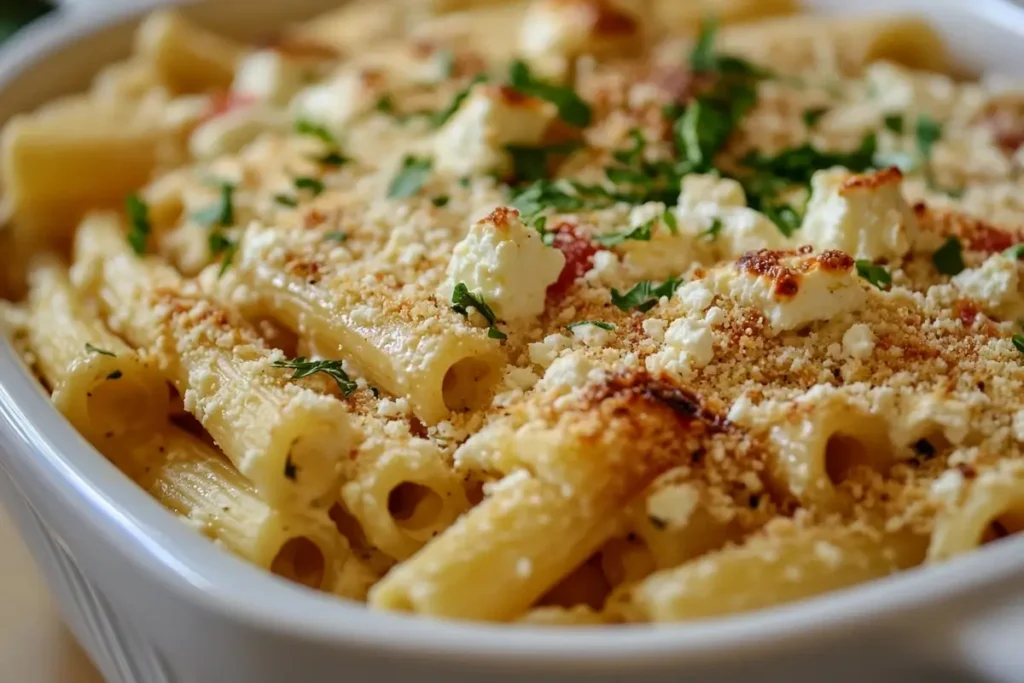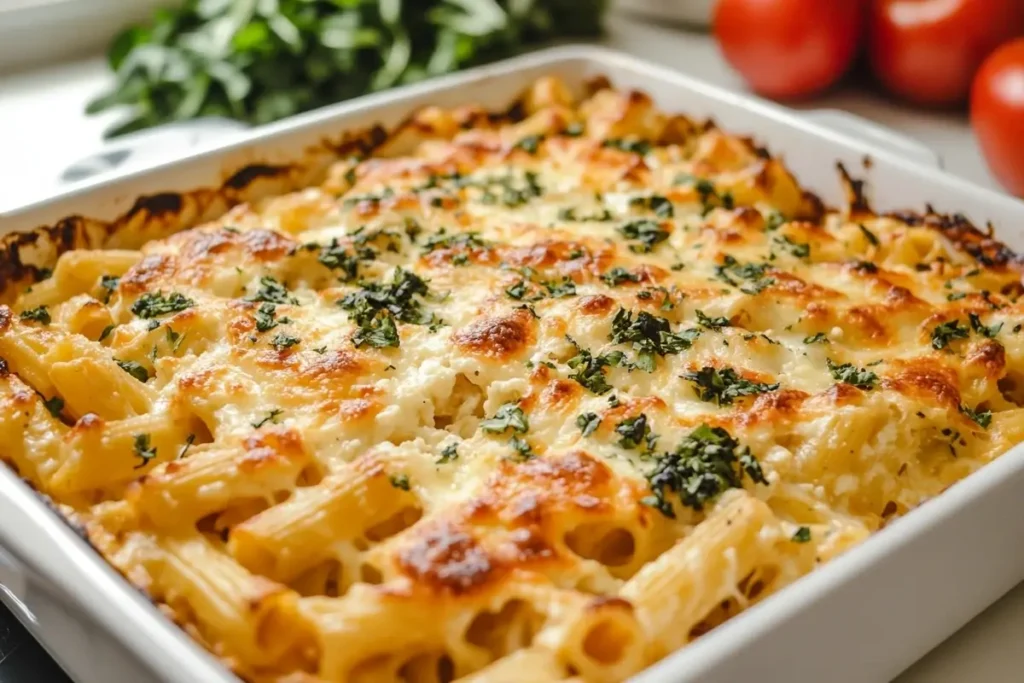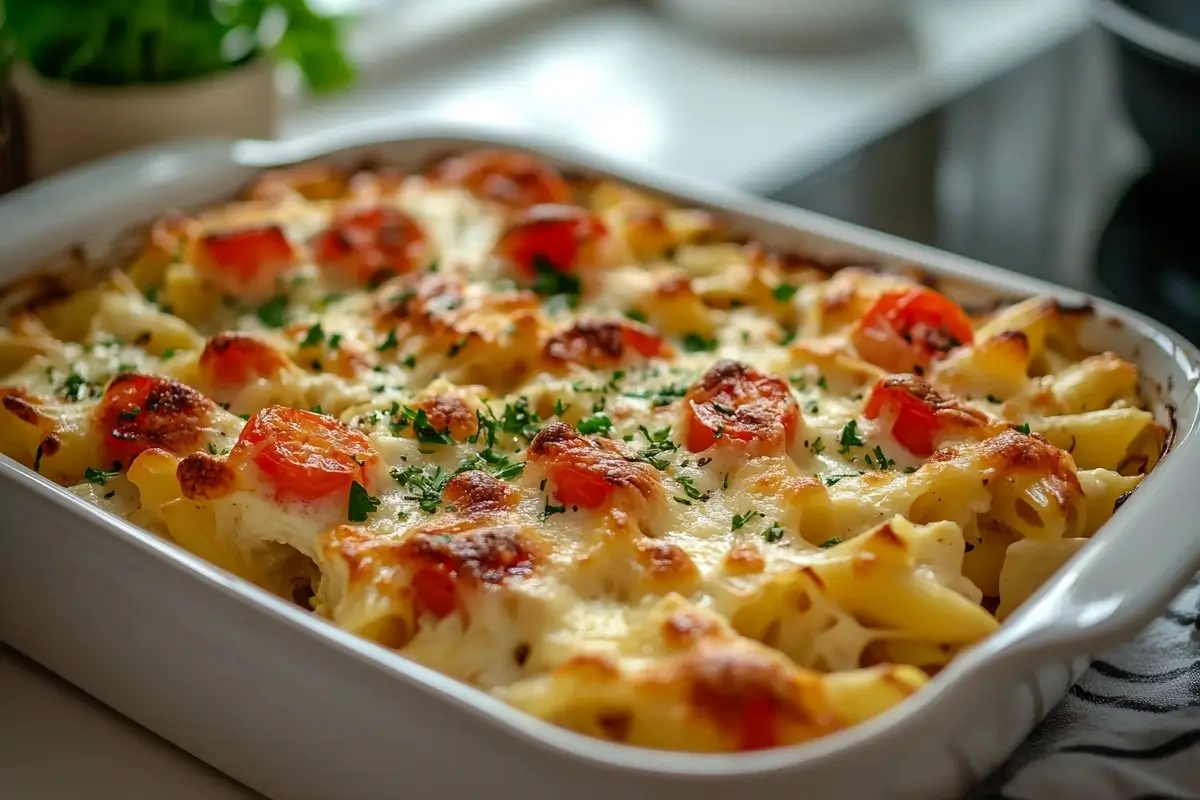Introduction
Baked Feta Pasta has soared in popularity thanks to its simple yet flavorful appeal. This incredible dish brings together tangy feta, sweet tomatoes, and comforting pasta in one baking pan. It’s perfect for busy nights when you want a hearty meal without fuss. In this guide, you’ll discover everything you need to know about this wonderful recipe, from ingredient selection to expert tips.
Image Placeholder 1: alt text “Baked Feta Pasta fresh from the oven”
The base of this recipe is fresh vegetables, aromatic herbs, and a generous block of feta cheese. Once baked, the feta melts into a creamy sauce that coats your pasta. Furthermore, you can customize the dish with extras like spinach, olives, or even roasted peppers. Because it’s so versatile, Baked Feta Pasta remains a top choice for quick, comforting dinners.
Baked Feta Pasta Origins
The idea behind Baked Feta Pasta seems straightforward, but it has a fascinating backstory. Food enthusiasts have been experimenting with roasted tomatoes and feta for years, although it only gained major popularity in recent times. Social media played a crucial role in making this recipe go viral.
Small coastal regions in Greece have traditionally used baked feta in various appetizers. Because feta is a staple in Greek cuisine, home cooks quickly found that combining it with fresh tomatoes results in a savory, creamy mixture. Adding pasta to that base only made it more satisfying. Therefore, many believe this dish pays homage to Mediterranean flavors, blending them with modern cooking shortcuts.
Image Placeholder 2: alt text “Block of feta cheese surrounded by cherry tomatoes”
Despite its recent fame, the core elements—cheese, tomatoes, and pasta—have been pleasing palates for generations. Baked Feta Pasta simply repackages these time-tested ingredients in a single, quick-to-assemble meal. Furthermore, the recipe’s success has spawned countless variations, each reflecting the creativity of food lovers worldwide.

The Essential Ingredients
Baked Feta Pasta relies on a few key components that elevate its taste. Paying attention to these details helps you prepare a meal that is both easy and memorable.
- Feta Cheese
Opt for a high-quality block of feta rather than pre-crumbled cheese. The block version melts more evenly and offers a richer flavor. Greek feta made from sheep’s milk is especially creamy. - Tomatoes
Cherry or grape tomatoes work best. They burst with sweetness when roasted, creating a contrasting flavor to the salty feta. Nevertheless, you can use any tomato variety if you slice them into smaller chunks. - Olive Oil
Choose extra-virgin olive oil for its robust taste and health benefits. This oil ensures the tomatoes roast to perfection, releasing their juices and pairing well with feta’s tanginess. - Herbs & Seasonings
Fresh basil, oregano, and a sprinkle of salt and pepper can transform basic ingredients into a gourmet affair. If you want more complexity, add crushed red pepper flakes or even minced garlic. - Pasta
Short pasta like penne, fusilli, or rigatoni captures the creamy feta-tomato mixture in every bite. That said, feel free to experiment with your preferred shape. - Optional Add-Ins
You can include spinach, olives, or mushrooms to enhance flavor and nutrition. Just be sure to adjust roasting times so these extras are perfectly cooked.

Ingredient Quality
Always prioritize the best-quality cheese and tomatoes you can find. Freshness makes a big difference in the dish’s final taste. The interplay between tangy feta and sweet roasted tomatoes is the essence of Baked Feta Pasta, so purchasing premium ingredients pays off.
Balancing Flavors
Because feta is naturally salty, it’s wise to taste your sauce before adding more salt. You can also incorporate a pinch of sugar to balance acidity if your tomatoes are not very sweet. Remember that baking helps caramelize the natural sugars in the tomatoes, so your sauce becomes richer over time.
Step-by-Step Preparation
Making Baked Feta Pasta is surprisingly simple. Below is a clear guide that walks you through each step to ensure a delicious outcome.
Step 1: Gather Your Ingredients
Before you begin, organize everything you need. Measure out pasta, unwrap the feta, wash the tomatoes, and set the herbs aside. This helps you move efficiently through the recipe without interruptions.
Step 2: Preheat the Oven
Preheat your oven to 400°F (200°C). This temperature allows the feta and tomatoes to roast evenly. If your oven runs hot, you can lower it slightly to 375°F (190°C). Keep an eye on the browning process so the feta doesn’t overcook.
Image Placeholder 3: alt text “Uncooked feta, tomatoes, and herbs in a baking dish”
Step 3: Assemble the Dish
Take a baking dish large enough to hold your block of feta and tomatoes in a single layer. Drizzle some olive oil into the dish, then place your feta block in the center. Surround it with cherry tomatoes. Next, add salt, pepper, and any herbs or seasonings you prefer.
Step 4: Roast the Feta and Tomatoes
Slide the dish into the preheated oven. Roast for about 20–30 minutes, or until the tomatoes blister and the feta looks golden brown on top. The timing can vary based on your oven, so keep checking to avoid burning.
Step 5: Cook the Pasta
While the feta and tomatoes bake, boil your pasta according to package instructions. Keep it al dente because it will cook a bit more when mixed with the hot sauce. Drain the pasta but reserve a small cup of the pasta water in case you need it to thin the sauce.
Step 6: Create the Sauce
Remove the feta-tomato dish from the oven. Use a spoon or spatula to mash the feta and tomatoes together, forming a smooth sauce. Toss in your cooked pasta. If it appears too thick, add a splash of the reserved pasta water.
Step 7: Garnish and Serve
Finally, add fresh basil leaves or other herbs for a burst of color. Serve the pasta piping hot. The creamy texture and tangy flavors make this dish stand out. Enjoy it with a simple side salad or crusty bread.
Tasty Variations
One of the best things about Baked Feta Pasta is how adaptable it can be. If you’re craving different flavors or want to switch things up, consider these ideas:
Spinach and Sun-Dried Tomatoes
For extra nutrients, add a few handfuls of fresh spinach in the last five minutes of baking. Sun-dried tomatoes also lend a deeper tomato flavor. Their chewy texture contrasts with the creamy sauce.
Olive and Artichoke Medley
Replace some of the tomatoes with artichoke hearts for a tangy twist. Toss in sliced olives for a more Mediterranean vibe. This version pairs especially well with a sprinkle of crushed red pepper flakes for subtle heat.
Mushrooms and Onions
Sauté sliced mushrooms and onions before adding them on top of the feta and tomatoes. This adds a lovely savory note. Finish with chopped parsley for a bright taste.
Chili and Garlic Boost
If you prefer a bolder kick, mash some roasted garlic into the feta. Meanwhile, sprinkle chili flakes over everything. This combination delivers a spicy yet balanced flavor profile.
Gluten-Free Pasta
Anyone following a gluten-free diet can substitute traditional pasta with gluten-free varieties. The creamy feta sauce still clings beautifully to these alternatives. Cook time may vary, so read the package instructions carefully.
Common Mistakes and How to Avoid Them
Even the simplest recipes can go wrong if you overlook certain details. Here are some pitfalls to watch out for:
- Overcooking the Feta
Leaving the feta in the oven too long can make it rubbery. Keep an eye on it, aiming for a golden brown crust rather than a dark brown one. - Using Low-Quality Cheese
Feta made from lower-quality cow’s milk can be grainy. Aim for authentic Greek feta for the smoothest, creamiest result. - Not Roasting the Tomatoes Enough
If you remove the dish from the oven too early, the tomatoes might not burst and release their juices. Make sure they look blistered and slightly wrinkled before you turn off the heat. - Skipping the Pasta Water
Without reserved pasta water, you risk a sauce that’s too thick or clumpy. The starchy water helps bind the sauce, giving it a velvety texture. - Lack of Seasoning
Feta is salty but don’t forget other herbs and spices. The dish can taste flat if you don’t add layers of flavor. Taste throughout the cooking process to perfect the seasoning.

Expert Tips for Perfect Results
Everyone wants a foolproof strategy for nailing Baked Feta Pasta every single time. Below are some advanced tricks that elevate your dish beyond the basics.
Pre-Season the Feta
Before placing the feta in the baking dish, rub it with a bit of olive oil and your chosen herbs. This infuses the cheese with extra flavor. A light sprinkle of paprika or chili powder can also add unexpected depth.
Rotate the Dish Midway
Halfway through baking, quickly rotate your dish to ensure even browning. If one side of the feta is more golden, turn the baking dish around. This is especially helpful if your oven has hot spots.
Add a Crunchy Topping
Some home cooks like to sprinkle breadcrumbs or crushed croutons over the dish just before it finishes baking. This adds a crispy contrast to the creamy sauce. Be sure to watch closely so the topping doesn’t burn.
Go Beyond Basil
While basil is a classic garnish, fresh mint or dill can also complement the tanginess of feta. Experiment with different herbs to see what works best for you.
Save Leftovers Properly
Leftover Baked Feta Pasta can be stored in an airtight container for up to three days. Reheat gently on the stovetop with a splash of milk or cream to restore its creamy texture. Avoid microwaving if possible, as it can make the pasta rubbery.
Image Placeholder 4: alt text “Creamy Baked Feta Pasta served in a white bowl”
Nutritional Overview
Though Baked Feta Pasta isn’t the lightest meal, it offers valuable nutrients from tomatoes, olive oil, and cheese. In moderation, feta provides calcium and protein, tomatoes supply vitamins, and olive oil offers heart-healthy fats. You can also use whole-grain pasta for additional fiber. Keep portion sizes reasonable, and pair the dish with a fresh salad or steamed vegetables for a balanced meal.
FAQ
Can you put feta cheese in pasta bake
Absolutely. Feta cheese adds a tangy, creamy element to pasta bakes. Because it melts and coats other ingredients, it blends well with roasted vegetables or sauces. When using feta in a pasta bake, ensure it has enough time to soften and release its flavors.
What temperature do you bake feta pasta
You typically bake feta pasta at around 400°F (200°C). This temperature ensures that the cheese browns slightly on top while the tomatoes roast to release their juices. If your oven tends to run hot, you can reduce the heat to 375°F (190°C) and keep an eye on the dish as it cooks.
How long to bake feta in the oven
It generally takes 20–30 minutes to bake feta in the oven until it’s soft and golden. The exact timing depends on your oven’s performance and the size of your feta block. Check every few minutes once you hit the 20-minute mark to avoid overcooking.
Is feta cheese good in pasta
Yes, feta cheese works wonderfully in pasta dishes. Its salty flavor and creamy texture pair well with various ingredients, especially tomatoes and olives. Feta also melts to form a rich sauce, making your pasta both flavorful and satisfying.

